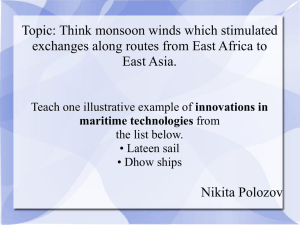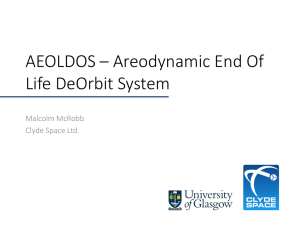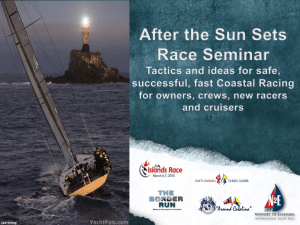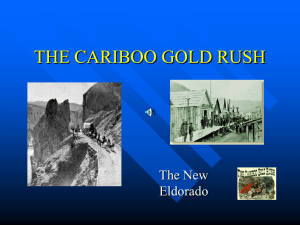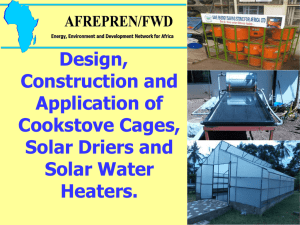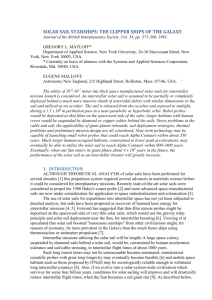5.48 MB pptx
advertisement
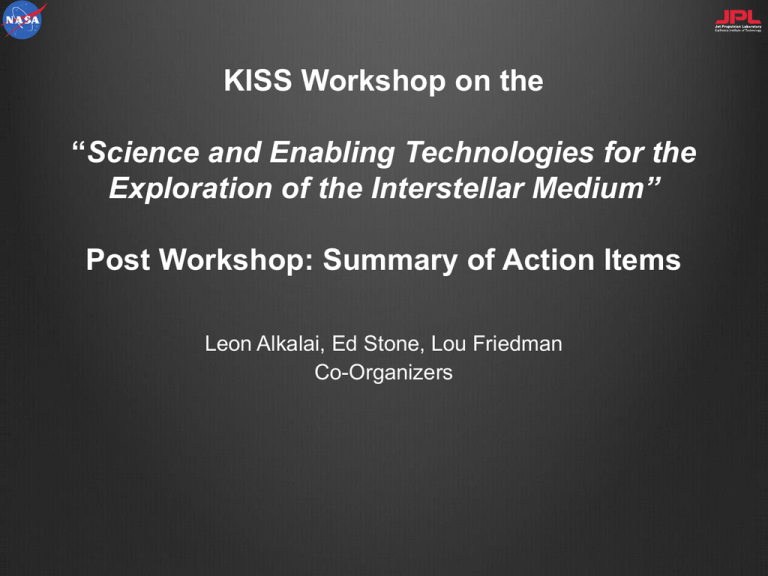
KISS Workshop on the “Science and Enabling Technologies for the Exploration of the Interstellar Medium” Post Workshop: Summary of Action Items Leon Alkalai, Ed Stone, Lou Friedman Co-Organizers Plan Towards Workshop #2 January 12th, 2015 • ALL: Next KISS workshop January 12th, 2015; mark your calendars; book your travel • Assume 3 full days. • ALL: review Action Item list (in this presentation) and provide any comments back to Leon Alkalai cc: Nitin Arora. • Science Team: Goals, Objectives due by November 17th, 2014 • Mission Team: Two Team X studies: Early December 2014 • Technology Team: updated briefings at the workshop January 12th, 2015 • Emerging Capabilities Team: present results at workshop January 12th, 2015 • ALL: KISS Final Study Report due March 15th, 2015 • ALL: Proposal for Technology Development Plan to KISS, April 1st, 2015 • ALL: KISS funding opportunity, October 1st, 2015 Overview of Action Items 1. Science • STM: Science Objectives, Measurements and Feasibility Assessment • Science / measurement Interactive Tool 2. Two Team X studies • 3. Technology Assessment • Miniaturization: Impact of Cubesats on the future of Space Exploration; instruments • Propulsion: Solar Sails (dual use, material testing, new deployment) • Communications: Optical or RF communication systems • Thermal management: thermal shield for perihelion burn • Avionics: Reliability, miniaturization, re-configurability using FPGA 4. Engineering Feasibility Study • 5. 1) Gravitational lensing; 2) Beamed energy; 3) Solar Sail scaling and perihelion burn Public Outreach • 6. 1) 100 AU in < 10 years; grand tour KBO + Centaurs; 2) Swarm of small probes into the LISM Formulate Plan; Public engagement; Explore avenue for non-governmental funds Develop Strategy to reach/influence Decadal Surveys AI-1: Science action item team leads • In-Situ Science: • • • Lead: Gary Zank Members: Merav Opher, Dick Mewaldt, Seth Redfield, Ralph McNutt, Paul Goldsmith, Jamie Rankin, Elena P., Adam Michael Topics: Plasma ISM, Neutral, Magnetic Field, Turbulence, Dust, ENA and backscatter Lyman-alpha • KB Science, Zodiacal Dust: • • • Lead: Mike Brown Members: Mark Swain, Mike Werner, Mike Shao Topics: KBOs, Dust detection and characterization, Understand utility of KB in terms of planetary formation • Astrometry, Astrophysics: • • • Lead: Mike Shao Members: Mark Swain, Slava Turyshev, Claudio Maccone, Mike Werner, Jared Males, Seth Redfield, Freeman Dyson Topics: Extra galactic parallaxes, masses of asteroids, centaurs, Exoplanets search, orphan planets search AI-1: Science action item: each team • Define: • Science goals • STM: Science Traceability Matrix approach • Quantify science objectives: • what is the value of science? • additional description requirements, how you meet them? • Measurements and instrument requirements: • Miniaturization • Key performance parameters and system requirements • Due date: • November 17th, 2014 • Will be reviewed at workshop January 12th, 2015 AI-1: Science Visualization Tool • Lead: Nitin Arora, Jamie, Elena, etc. • Show log scale, linear scale ( to and from ) • Show Voyager and other spacecraft • Polar plot (top view) showing various local ISM regions • Highlight various science disciplines (planetary, Heliophysics, astrophysics etc.) • Include interactive behavior • Understand and develop educational aspects of the tool • Illustrate KBOs in some scientific detail • Combined science case: Heliophysics, Astrophysics, Planetary Science • Follow up with Ellan Stofan, NASA CS • 3D navigation AI-1: Science Visualization Tool (draft) Heliopause Termination Shock Interstellar wind Pristine ISM Cosmology, Inner Oort cloud Hydrogen wall structure Asteroids CIRB observation KB, Local Dust, Zodiacal, Bow shock/ wave CMB observations Interstellar Relay satellite, Interstellar Dust Foreground emissions, Parallax science, Cosmic rays Gravitational tests, Neutrals, Ions, Magnetic field, Organics, Turbulence, Dust Neutrino Gravitational lens 0 100 200 300 400 Solar Gravitational lens 500 600 700 Distance (AU) Investigate possibility of LOG scale 800 900 1000 1100 AI-1: Science Visualization Tool (draft) Heliopause Termination Shock Interstellar wind Pristine ISM Cosmology, Inner Oort cloud Hydrogen wall structure CIRB observation Asteroids KB, Local Dust, Zodiacal, Bow shock/ wave Relay satellite, Interstellar Dust Foreground emissions, Parallax science, Cosmic rays Gravitational tests, Neutrals, Ions, Magnetic field, Organics, Turbulence, Dust Neutrino Gravitational lens 0 100 200 300 400 Solar Gravitational lens, CMB 500 600 700 Distance (AU) Investigate possibility of LOG scale 800 900 1000 1100 AI-2: Team-X Mission Study 1 100 AU in ~10 years • Assume SLS lift capability • Investigate Trajectory options: Jupiter flyby to achieve perihelion; Direct Jupiter flyby escape • Analogy to Grand tour: Centaur and KBO flyby • Critical event analysis: Perihelion burn: • Cruise phase science team: Mark Swain, Mike Shao, Seth, Jarred, Mike W., Phil Lubin • Credible design for a 2-3 stage solid (SRM) with heat shield • Thermal Protection System scaling AI-2: Team-X Mission Study 2 • Members: Paullette, Dick M., Merav Opher, Manan, Darrell, Jamie, Freeman, Leon, Nitin, Adam • Swarm of probes to cross the heliopause • How small can you make the probe? • How many? • How fast can they escape ? • Miniaturization ‘revolution’ • CubeSat analogy for interstellar missions AI-2: Possible Tech Demo missions • Solar Reflector to simulate Low Perihelion • • • • • • Test solar heat shield Test SRM inside the shield at elevated temperatures Solar sail material testing Increase sail loading (g/m2) and sail specific weight • Packaging, origami deployment Part of the test in Earth orbit Some ground testing possible (France) • Small Spacecraft Lifetime Mission • • • Long distance Com. Kuiper Belt and beyond ( target 100 AU in 10 years ) • • • • Small instruments when possible REP SRM at Jupiter Hibernation Laser-Sail / Beam propulsion Demo • Small Sail + Laser from earth or small-sat AI-3: Technology Assessment Update • Miniaturization update, Rob Staehle • • • Propulsion, Les Johnson • Solid rocket motor lifetime qualification and near perihelion burn • Light weight, Dual use sails; Sail material testing for close solar pass • Radio Isotope based Electric Propulsion/ Low power long life Thrusters Telecommunications, Abhi Biswas • • • Update on CubeSats, integrated avionics and instruments Deployable / Inflatables antennas; Sail as an antenna; Solid state Optical comm. Thermal / Shield, Ralph McNutt • Solar heat shield (test Carbon-Carbon shield with new configurations) • Magnetic and Electro static Shielding; Thermal management Avionics: G&NC, Reliability and Resilience, Leon Alkalai • FPGAs, Hibernation, Wafer scale systems; Systems on a chip; Radiation tolerance AI-4: Engineering Feasibility Study: Beamed Energy Engineering Study • Members: Phil Lubin, Lou Friedman • Provide a reasonable engineering implementation concept • Propose a technology demonstration concept • Present results at the January workshop AI-4: Engineering Feasibility Study: Gravitational Lensing • Members: Jared, Slava, Caludio, Mike (Shao), Mark Swain • Define science objectives? • Can it be done and how? • What would the image of the Earth look like? • Identify other engineering constraints. AI-4: Engineering Feasibility Study Solar Sail Trade Study • Members: Lou, Les, Darren, Nathan Barnes, Manan • How close to the Sun can you go? • What is the best sail density or sail specific weight possible? • What would it take to design a 150 m (radius) Sail ? How much would the sail + sail sub-system weigh ? • Dual use question: other uses of Solar Sail ? AI-5: Public Outreach Plan • Study lead: Mae Jemison, Lou Friedman, Leon Alkalai • Public outreach: crossing of Voyager, Scientific American, National Geographic, NPR • Work with JPL Blaine Baggett to come up with ideas, • Minute Physics outreach – a series of lectures on youtube • Target and work with existing groups like 100YSS program and others • Ideas for Crowdsourcing a first mission or tech demo mission • Present ideas at the January workshop AI-6: Develop a plan to (inform) Influence the Decadal Surveys Study Lead: Paul Goldsmith, Mike Werner Target Decadal Surveys: • Astrophysics • Planetary • Heliophysics AI-6: Grand Vision of a Grand Challenge Interstellar Exploration Program Technology Demonstration, Science Discovery Technology Demonstration Missions 1 – 10 AU Small Explorers LISM and Heliosphere Multi-Probes 5 – 100 AU Medium Scale Missions 200 – 300 AU Large Scale Missions 500 - 600 AU Thousand AU challenge 1000 AU 50 years Advanced Studies, Technology Maturation, Technology Development


